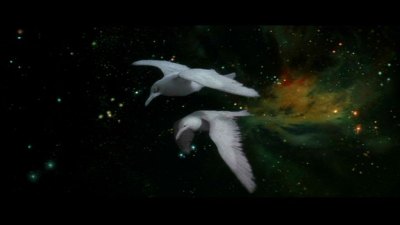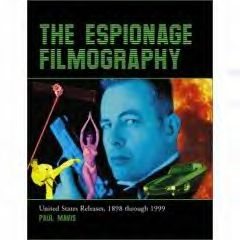| Reviews & Columns |
|
Reviews DVD TV on DVD Blu-ray 4K UHD International DVDs In Theaters Reviews by Studio Video Games Features Collector Series DVDs Easter Egg Database Interviews DVD Talk Radio Feature Articles Columns Anime Talk DVD Savant Horror DVDs The M.O.D. Squad Art House HD Talk Silent DVD
|
DVD Talk Forum |
|
|
| Resources |
|
DVD Price Search Customer Service #'s RCE Info Links |
|
Columns
|
|
|
Jonathan Livingston Seagull
Far out, birdbrain.

Does anybody under 40 even know about Jonathan Livingston Seagull, the pseudo-Christian/Eastern philosophy hodgepodge parable by Richard Bach that became a mammoth best seller back in 1970? To people who grew up during the early Seventies, a tattered blue paperback copy of Jonathan Livingston Seagull was as iconic a symbol of the times as macrame fern holders, waterbeds, big orange incense candles, earth shoes, and a VW Microbus parked out front, with that ghostly white image of Jonathan resting on bookshelves made out of cinder blocks and boards, nestled safely between cherished copies of Love Story and the Collected Poems of Rod McKuen (with two Pet Rocks for bookends). Everybody read that stupid goddamn book.
So when Paramount blew about 1.5 million on the live-action feature film version of the bestseller, a lot of people in Hollywood scratched their beaks in amazement. After all, how the hell were you going get across Bach's banal, quasi-religious parable by using real birds? I distinctly remember being plopped down in a theater seat with a bunch of other kids to watch this aviary The Razor's Edge (Jonathan Livingston Seagull carried the dreaded "G" rating, so parents could safely skip it), and walking out...um...actually liking it. Now, I know for a fact that my older brothers enjoyed it. Because when they went with me they were stoned out of their gourds. They had heard it was a "head trip," and packed their snacks accordingly. As I occasionally glanced back and forth between them as their eyes pinwheeled into their skulls, I sat back and marveled at some truly spectacular scenery, while I tried to figure out what the hell Jonathan was talking about ("Wait...you can go somewhere you've never been before, by already being there? Pass the Rasinettes.").
If you don't know Jonathan Livingston Seagull (or at least the story that's used in the movie -- they changed it from the novel), it concerns a sensitive, questioning seagull named Jonathan Livingston Seagull (voiced by James Franciscus), who wants more out of his life than just scavenging for fish heads like the rest of his Flock. Trying to master high-speed flight, he's castigated by the Elders of the Flock (head elder bird by Hal Holbrook) for not only pursuing the useless skill of speed, but also, more dangerously, for flouting the conventions of the Flock, and for being an individual bird (a heavy, heavy theme in 1970, man). Almost killing himself before mastering 200mph-plus flight, he is banished from the Flock, and must find his own way in life.

Flying around the world, Jonathan dies (or does he really die?) and is found by new gulls (in a strange world where colors are reversed or washed out) who understand his quest. Maureen (voice of Juliet Mills) offers to teach Jonathan, but she realizes that he's far more advanced than most birds "at this level of existence," and offers to introduce him to super-bird Chaing (voice of Philip Ahn), who lays down a major freak-out to Jonathan by telling him "perfection" is attainable if you already believe you are; that instantaneous flight to anywhere in the cosmos is possible if you already believe you're "there," and that the body is just a manifestation of the mind. Jonathan, inspired by his teachings and learning what "love" really is, goes back to his flock, where he brings back to life a young disciple, Fletcher (voice of David Ladd), with people calling him the "Son of the Great Gull." Having achieved perfection, he leaves the flock to help others.
Watching Jonathan Livingston Seagull today, I pretty much had the same reaction I had seeing it thirty-four years ago. It's a spectacular-looking film, with images of the California coast battered by massive waves rivaling anything I've seen on film. Equally amazing are the scenes of Jonathan, flying around the various locales. There's one shot in particular, at the beginning of the film, where the helicopter camera swoops around a jagged outcropping of rocks, with Jonathan perfectly alighting on it at just the right moment as the copter goes by - what an amazing shot to capture. Numerous evocative sequences like that are caught in Jonathan Livingston Seagull, including a particular favorite where Jonathan tentatively makes his way across a sea of red sand in the desert.
The flying scenes are quite impressive, as well, with a stunt plane used to capture some of the high-speed flying, as seen from Jonathan's perspective. Now I understand that fake, remote-controlled gliders were used for some of the bird shots - if they were, I couldn't really tell (so how did they get that realistic shot of a gull smashing into the side of cliff? Better not ask). And some of the color reversals in the "Heaven" sequences are quite arresting; if nothing else, you can just groove on Jonathan Livingston Seagull much like my stoned brothers no doubt did.

But serious drawbacks arise anytime music swells up on Jonathan Livingston Seagull's soundtrack, or some actor opens his beak - which is distressingly all the time. Neil Diamond won a Grammy for the soundtrack of Jonathan Livingston Seagull, but seriously, it's one of the most bombastic, puerile pieces of music I've ever heard. Ladled on each and every scene in the film, Diamond's turgid music screams, "Listen to me! I'm important! I'm significant!" at every stop, never giving the viewer a moment's peace to actually contemplate the beauty of the scenery (or the ridiculousness of the dialogue). His songs are, if possible, even worse. With a penchant for repeating the same two or three-word phrase over and over again, these stunningly inept dirges are as grating as they are frequently indecipherable (I recommend the close-captioning to get what Diamond is screeching about).
As for the voice work, I suppose there was no other way to translate Bach's asinine hippie-crap amalgamation of Christianity, reincarnation, Eastern philosophy, The Power of Positive Thinking, and Leave it to Beaver (if you don't think so, check out the episode where the Beav likens a hole in the street to the Grand Canyon - trippy) than by using voice-over narration, but christ; does it have to sound like Franciscus was channeling William Shatner (can you imagine the possibilities had they scored him for the role?)? Franciscus, an actor I always enjoyed (Longstreet rules), plays Jonathan like every single word was spoken for the very first time by a human (or bird). He gushes, he trembles, he...hesitates every single line until we fear that Jonathan has taken one too many high dives to the head.
Of course it doesn't help that the dialogue he's given is frequently for the birds (what, I'm not going to use that one?). I actually didn't mind the story so much; after all, this is Jonathan Livingston Seagull for christ sakes; you were expecting maybe Shakespeare? It isn't supposed to be any good. It's the worst kind of New Agey drivel that even people back in the Seventies didn't really buy (they only used it to pick up people, actually). Does Jonathan die? Does he go to "heaven?" Is he reincarnated? Is he Christ? Cripes! Who cares? Trying to incorporate every major form of philosophical thought, Jonathan Livingston Seagull winds up embarrassing them all, becoming the ethical and metaphysical equivalent of, "Hey, baby; what's your sign?" And actually, that's cool with me. It's a parable - you're not supposed to take it seriously. But each and every time you try to give Jonathan Livingston Seagull its due, you realize all this intangible, incorporeal gobbledygook is supposed to be coming out of freaking birds, and the waves of laughter just roll on and on, man.

The DVD:
The Video:
The anamorphically enhanced, 2.35:1 widescreen video transfer for Jonathan Livingston Seagull is surprisingly good, considering the obscurity of the title. Although the second half has noticeable color washes and scratches at certain points, the shots of the California coast are truly spectacular, and look very good in this transfer. Color hues are varied and true (important during the color-shift sequences), while the brightness of the image (again important during the "positive-negative Heaven" sequences) carefully modulated.
The Audio:
The Dolby Digital English mono sound mix is probably the exact same way the film was released -- and thank god for that; the thought of Neil Diamond's incoherent warbling in 5.1 is truly frightening. English subtitles are available.
The Extras:
There are, unfortunately, no extras for Jonathan Livingston Seagull. It would have been nice to see something on how the bird effects were done, or on the reception of the film, but it's understandable that this notorious flop with the critics wouldn't garner any special treatment.
Final Thoughts:
Perhaps ripe for rediscovery, Jonathan Livingston Seagull is the goddamnedest movie I've seen this year. At times stunningly beautiful, at others (in fact, most of the time) insipid and trite, Jonathan Livingston Seagull can be watched on so many different levels (most of them bad), that it's hard to say "skip it" because when all's said and done, it's such a truly weird, conflicted experience, I hesitate to steer you away from it. You might just love it, man. I'm...er...recommending Jonathan Livingston Seagull (and kissing all my cred goodbye).
Paul Mavis is an internationally published film and television historian, a member of the Online Film Critics Society, and the author of The Espionage Filmography.


|
| Popular Reviews |
| Sponsored Links |
|
|
| Sponsored Links |
|
|
| Release List | Reviews | Shop | Newsletter | Forum | DVD Giveaways | Blu-Ray | Advertise |
|
Copyright 2024 DVDTalk.com All Rights Reserved. Legal Info, Privacy Policy, Terms of Use,
Manage Preferences,
Your Privacy Choices | |||||||













